初中双宾语讲解和练习
- 格式:doc
- 大小:37.00 KB
- 文档页数:7
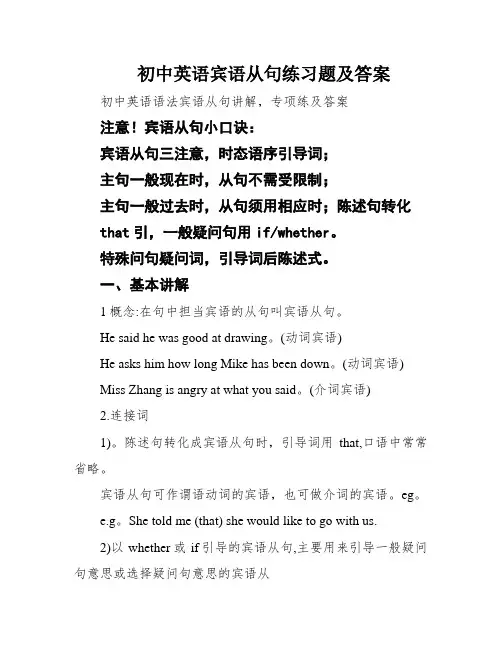
初中英语宾语从句练习题及答案初中英语语法宾语从句讲解,专项练及答案注意!宾语从句小口诀:宾语从句三注意,时态语序引导词;主句一般现在时,从句不需受限制;主句一般过去时,从句须用相应时;陈述句转化that引,一般疑问句用if/whether。
特殊问句疑问词,引导词后陈述式。
一、基本讲解1概念:在句中担当宾语的从句叫宾语从句。
He said he was good at drawing。
(动词宾语)He asks him how long Mike has been down。
(动词宾语)Miss Zhang is angry at what you said。
(介词宾语)2.连接词1)。
陈述句转化成宾语从句时,引导词用that,口语中常常省略。
宾语从句可作谓语动词的宾语,也可做介词的宾语。
eg。
e.g。
She told me (that) she would like to go with us.2)以whether或if引导的宾语从句,主要用来引导一般疑问句意思或选择疑问句意思的宾语从句,从句一样是XXX说语序eg。
I wonder if /whether u have told the new to Li Lei。
注意:一般情况下,whether和if可以互用,但有些情况例外。
a.当从句做介词的宾于是只用whether不用ifeg。
XXX about whether we'll go on the pinic.b.指导词与动词不定式或not连用时,只用whether.eg。
Please let me know what to do next.Could you tell me whether u go or not?c。
if当如果讲时,引导的是条件状语从句,这时不能用whether.3).非凡疑问句转化成宾语从句时,指导词用非凡疑问词;指导词后要用XXX说句语序。
Eg。
Could you tell me what's the matter\wrong with you?特殊情况。
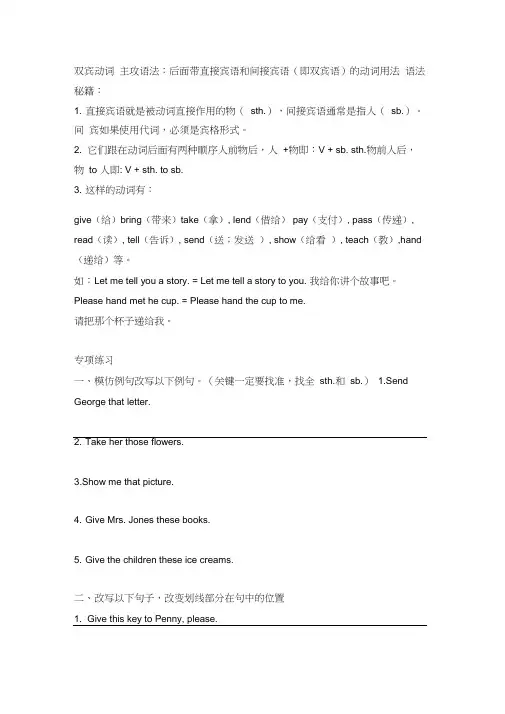
双宾动词主攻语法:后面带直接宾语和间接宾语(即双宾语)的动词用法语法秘籍:1. 直接宾语就是被动词直接作用的物(sth.),间接宾语通常是指人(sb.)。
间宾如果使用代词,必须是宾格形式。
2. 它们跟在动词后面有两种顺序人前物后,人+物即:V + sb. sth.物前人后,物to 人即: V + sth. to sb.3. 这样的动词有:give(给)bring(带来)take(拿), lend(借给) pay(支付), pass(传递), read(读), tell(告诉), send(送;发送), show(给看), teach(教),hand (递给)等。
如:Let me tell you a story. = Let me tell a story to you. 我给你讲个故事吧。
Please hand met he cup. = Please hand the cup to me.请把那个杯子递给我。
专项练习一、模仿例句改写以下例句。
(关键一定要找准,找全sth.和sb.) 1.Send George that letter.2. Take her those flowers.3.Show me that picture.4. Give Mrs. Jones these books.5. Give the children these ice creams.二、改写以下句子,改变划线部分在句中的位置1. Give this key to Penny, please.2. Don' t give that one to him.3. Send these flowers to her.4. Don' t show your homework to Sam.5. Bring these magazines to Sally.6. Hand the hammer to your father.7. Don' t send these tickets to them.8. Can you lend an English book to me?9. Pass the ball to her, please.10. Tell the truth to me.三、汉译英。
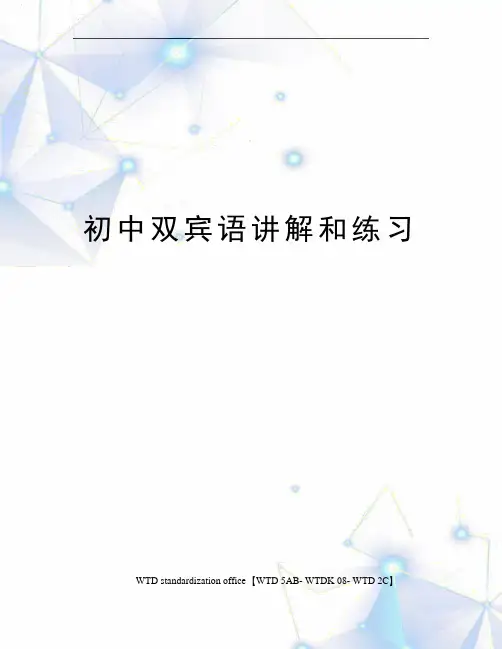
初中双宾语讲解和练习 WTD standardization office【WTD 5AB- WTDK 08- WTD 2C】双宾动词主攻语法:后面带直接宾语和间接宾语(即双宾语)的动词用法语法秘籍:1.直接宾语就是被动词直接作用的物(sth.),间接宾语通常是指人(sb.)。
间宾如果使用代词,必须是宾格形式。
2. 它们跟在动词后面有两种顺序人前物后,人+物即:V + sb. sth.物前人后,物to 人即: V + sth. to sb.3.这样的动词有:give(给)bring(带来)take(拿), lend(借给) pay(支付), pass(传递), read(读), tell(告诉),send(送;发送), show(给看), teach(教),hand(递给)等。
如:Let me tell you a story. = Let me tell a story to you. 我给你讲个故事吧。
Please hand met he cup. = Please hand the cup to me.请把那个杯子递给我。
专项练习一、模仿例句改写以下例句。
(关键一定要找准,找全sth.和sb.)George that letter. ___________________________________________________her those flowers. ____________________________________________________me that picture. _____________________________________________________Mrs. Jones these books. _____________________________________________________the children these ice creams._____________________________________________________二、改写以下句子,改变划线部分在句中的位置。
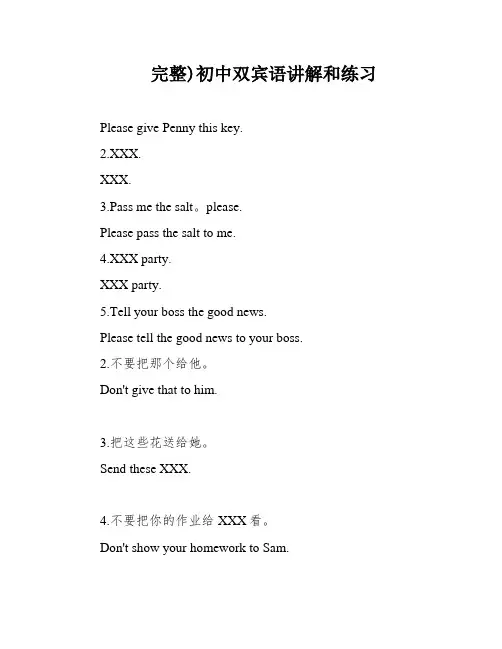
完整)初中双宾语讲解和练习Please give Penny this key.2.XXX.XXX.3.Pass me the salt。
please.Please pass the salt to me.4.XXX party.XXX party.5.Tell your boss the good news.Please tell the good news to your boss.2.不要把那个给他。
Don't give that to him.3.把这些花送给她。
Send these XXX.4.不要把你的作业给XXX看。
Don't show your homework to Sam.5.把这些杂志带给XXX。
XXX.6.把锤子交给你的父亲。
XXX.7.不要把这些票寄给他们。
XXX.8.你能借给我一本英语书吗?Can you lend me an English book?9.请把球传给她。
Pass the ball to her。
please.10.告诉我真相。
Tell me XXX.1.I plan to send her some flowers.1.Please send the package to my friend.2.Don't show the letter to your friends.3.Can you pass me a glass of water?4.I want to send the XXX.5.Please give these gifts to the children.6.I took him to school.7.XXX.8.XXX.9.Who are you planning to send those photos to?XXX that can take two objects with the XXX "to": awardbringhandXXXmailofferowepasspaypostreadreturnsendsellXXXShow sth。
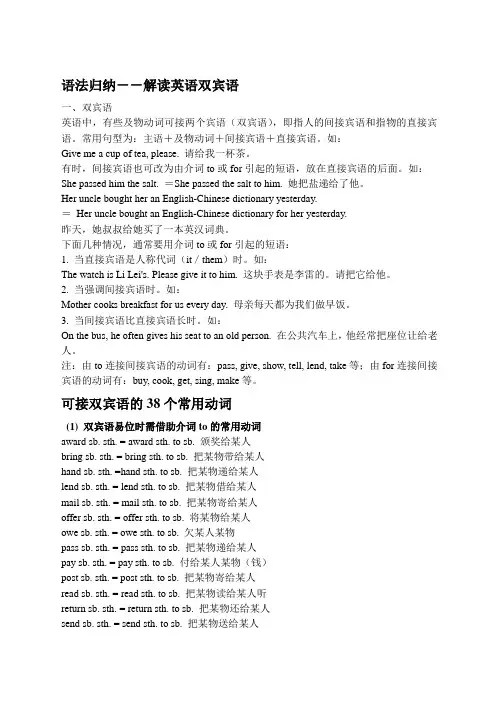
语法归纳--解读英语双宾语一、双宾语英语中,有些及物动词可接两个宾语(双宾语),即指人的间接宾语和指物的直接宾语。
常用句型为:主语+及物动词+间接宾语+直接宾语。
如:Give me a cup of tea, please. 请给我一杯茶。
有时,间接宾语也可改为由介词to或for引起的短语,放在直接宾语的后面。
如:She passed him the salt. =She passed the salt to him. 她把盐递给了他。
Her uncle bought her an English-Chinese dictionary yesterday.=Her uncle bought an English-Chinese dictionary for her yesterday.昨天,她叔叔给她买了一本英汉词典。
下面几种情况,通常要用介词to或for引起的短语:1. 当直接宾语是人称代词(it/them)时。
如:The watch is Li Lei's. Please give it to him. 这块手表是李雷的。
请把它给他。
2. 当强调间接宾语时。
如:Mother cooks breakfast for us every day. 母亲每天都为我们做早饭。
3. 当间接宾语比直接宾语长时。
如:On the bus, he often gives his seat to an old person. 在公共汽车上,他经常把座位让给老人。
注:由to连接间接宾语的动词有:pass, give, show, tell, lend, take等;由for连接间接宾语的动词有:buy, cook, get, sing, make等。
可接双宾语的38个常用动词(1) 双宾语易位时需借助介词to的常用动词award sb. sth. = award sth. to sb. 颁奖给某人bring sb. sth. = bring sth. to sb. 把某物带给某人hand sb. sth. =hand sth. to sb. 把某物递给某人lend sb. sth. = lend sth. to sb. 把某物借给某人mail sb. sth. = mail sth. to sb. 把某物寄给某人offer sb. sth. = offer sth. to sb. 将某物给某人owe sb. sth. = owe sth. to sb. 欠某人某物pass sb. sth. = pass sth. to sb. 把某物递给某人pay sb. sth. = pay sth. to sb. 付给某人某物(钱)post sb. sth. = post sth. to sb. 把某物寄给某人read sb. sth. = read sth. to sb. 把某物读给某人听return sb. sth. = return sth. to sb. 把某物还给某人send sb. sth. = send sth. to sb. 把某物送给某人sell sb. sth. = sell sth. to sb. 把某物卖给某人serve sb. sth. = serve sth. to sb. 拿某物招待某人show sb. sth. = show sth. to sb. 拿某物给某人看take sb. sth. = take sth. to sb. 把某物拿给某人teach sb. sth. = teach sth. to sb. 教某人某物tell sb. sth. = tell sth. to sb. 告诉某人某情况throw sb. sth. = throw sth. to sb. 把某物扔给某人write sb. sth. = write sth. to sb. 给某人写信(2) 双宾语易位时需借助介词for的常用动词book sb. sth. = book sth. for sb. 为某人预定某物buy sb. sth. = buy sth. for sb. 为某人买某物choose sb. sth. = choose sth. for sb. 为某人选某物cook sb. sth. = cook sth. for sb. 为某人煮某物draw sb. sth. = draw sth. for sb. 为某人画某物fetch sb. sth. = fetch sth. for sb. 为某人去取某物find sb. sth. = find sth. for sb. 为某人找到某物fix sb. sth. = fix sth. for sb. 为某人准备某物get sb. sth. = get sth. for sb. 为某人拿来某物make sb. sth. = make sth. for sb. 为某人做某物order sb. sth. = order sth. for sb. 为某人订购某物pick sb. sth. = pick sth. for sb. 为某人采摘某物prepare sb. sth. = prepare sth. for sb. 为某人准备某物save sb. sth. = save sth. for sb. 为某人留某物sing sb. sth. = sing sth. for sb. 为某人唱某物(歌)spare sb. sth. = spare sth. for sb. 为某人让出某物steal sb. sth. = steal sth. for sb. 为某人偷某物注:有的动词后接的双宾语易位时,既可用介词to引出间接宾语,也可用介词for 引出间接宾语,含义相同,如bring,play等:Bring me today’s paper. = Bring today’s paper to [for] me. 把今天的报纸拿给我。
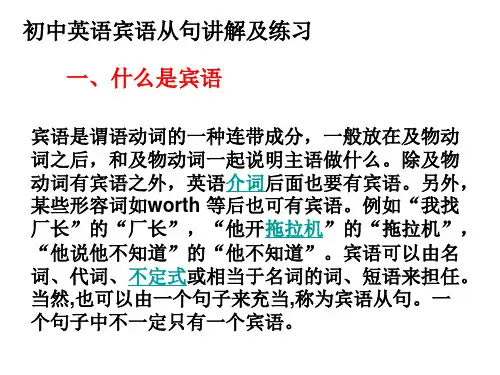
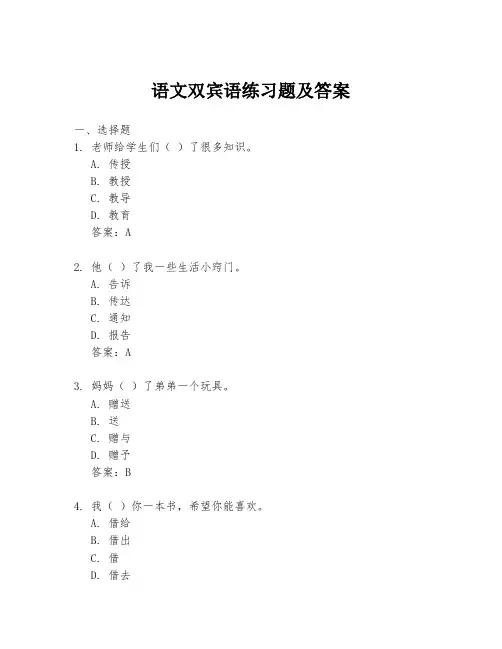
语文双宾语练习题及答案一、选择题1. 老师给学生们()了很多知识。
A. 传授B. 教授C. 教导D. 教育答案:A2. 他()了我一些生活小窍门。
A. 告诉B. 传达C. 通知D. 报告答案:A3. 妈妈()了弟弟一个玩具。
A. 赠送B. 送C. 赠与D. 赠予答案:B4. 我()你一本书,希望你能喜欢。
A. 借给B. 借出C. 借D. 借去答案:A5. 他()了我一些建议。
A. 提供B. 提出C. 提示D. 提醒答案:B二、填空题6. 请()我一些关于这个问题的详细信息。
答案:提供7. 老师()了我们一些学习方法,帮助我们更好地学习。
答案:教授8. 他()了我一个挑战,让我在规定时间内完成。
答案:提出了9. 我()了你一个承诺,我会尽快兑现。
答案:做出了10. 她()了孩子们一些故事,让他们晚上安静下来。
答案:讲述了三、改错题11. 他告诉了我一些建议,我决定采纳。
错误:告诉正确:提出了12. 老师教授了我们很多知识,我们受益匪浅。
错误:教授正确:传授13. 我借给朋友一本书,希望他能喜欢。
错误:借给正确:借了14. 妈妈赠与了我一个礼物,我非常感动。
错误:赠与正确:赠送15. 他通知了我一个消息,让我感到惊讶。
错误:通知正确:告诉四、造句题16. 用“赠送”造句。
答案:在生日那天,我的好朋友赠送了我一本珍贵的书。
17. 用“教授”造句。
答案:这位经验丰富的教授教授了我们许多宝贵的人生经验。
18. 用“提出”造句。
答案:在会议上,他提出了一个创新的想法,引起了大家的热烈讨论。
19. 用“借给”造句。
答案:图书馆借给了我一本我期待已久的小说。
20. 用“告诉”造句。
答案:老师告诉我,勤奋是成功的关键。
通过这些练习题,可以帮助学生更好地理解和掌握双宾语的用法,提高他们的语文应用能力。
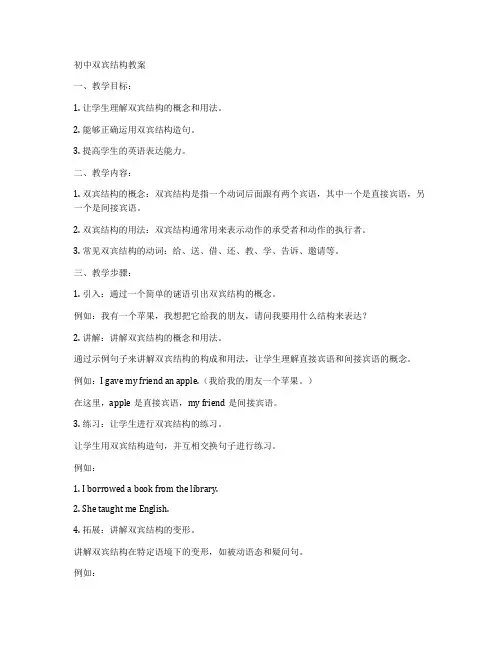
初中双宾结构教案一、教学目标:1. 让学生理解双宾结构的概念和用法。
2. 能够正确运用双宾结构造句。
3. 提高学生的英语表达能力。
二、教学内容:1. 双宾结构的概念:双宾结构是指一个动词后面跟有两个宾语,其中一个是直接宾语,另一个是间接宾语。
2. 双宾结构的用法:双宾结构通常用来表示动作的承受者和动作的执行者。
3. 常见双宾结构的动词:给、送、借、还、教、学、告诉、邀请等。
三、教学步骤:1. 引入:通过一个简单的谜语引出双宾结构的概念。
例如:我有一个苹果,我想把它给我的朋友,请问我要用什么结构来表达?2. 讲解:讲解双宾结构的概念和用法。
通过示例句子来讲解双宾结构的构成和用法,让学生理解直接宾语和间接宾语的概念。
例如:I gave my friend an apple.(我给我的朋友一个苹果。
)在这里,apple是直接宾语,my friend是间接宾语。
3. 练习:让学生进行双宾结构的练习。
让学生用双宾结构造句,并互相交换句子进行练习。
例如:1. I borrowed a book from the library.2. She taught me English.4. 拓展:讲解双宾结构的变形。
讲解双宾结构在特定语境下的变形,如被动语态和疑问句。
例如:1. The book was borrowed from the library.(被动语态)2. Who did you give the pen to?(疑问句)5. 总结:对本节课的内容进行总结,强调双宾结构的重要性和用法。
四、教学评价:1. 课堂练习:观察学生在练习中的表现,判断他们是否掌握了双宾结构的用法。
2. 课后作业:布置有关双宾结构的作业,让学生巩固所学知识。
3. 课堂提问:通过提问了解学生对双宾结构的理解程度。
五、教学延伸:1. 让学生尝试用双宾结构编写小故事。
2. 引导学生关注日常生活中的双宾结构用法。
3. 组织双宾结构的主题活动,提高学生的实际运用能力。
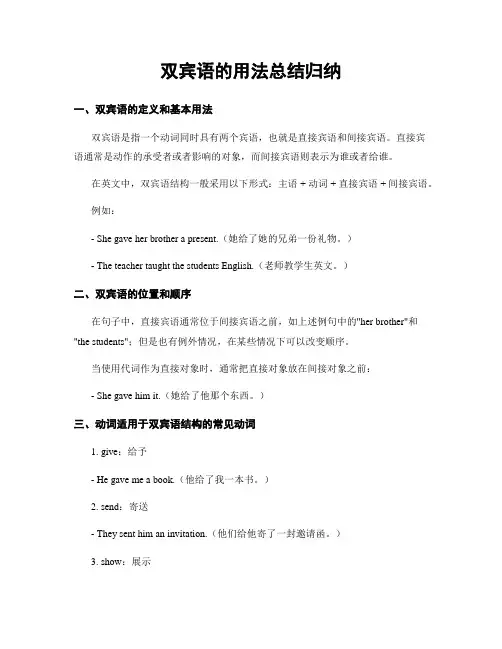
双宾语的用法总结归纳一、双宾语的定义和基本用法双宾语是指一个动词同时具有两个宾语,也就是直接宾语和间接宾语。
直接宾语通常是动作的承受者或者影响的对象,而间接宾语则表示为谁或者给谁。
在英文中,双宾语结构一般采用以下形式:主语 + 动词 + 直接宾语 + 间接宾语。
例如:- She gave her brother a present.(她给了她的兄弟一份礼物。
)- The teacher taught the students English.(老师教学生英文。
)二、双宾语的位置和顺序在句子中,直接宾语通常位于间接宾语之前,如上述例句中的"her brother"和"the students";但是也有例外情况,在某些情况下可以改变顺序。
当使用代词作为直接对象时,通常把直接对象放在间接对象之前:- She gave him it.(她给了他那个东西。
)三、动词适用于双宾语结构的常见动词1. give:给予- He gave me a book.(他给了我一本书。
)2. send:寄送- They sent him an invitation.(他们给他寄了一封邀请函。
)3. show:展示- She showed her friends some pictures.(她给她的朋友们展示了一些图片。
)4. tell:告诉- He told me a secret.(他告诉了我一个秘密。
)5. teach:教- The professor taught the students a new theory.(教授教了学生们一个新理论。
)注意,以上动词也可以使用其他结构,如带有介词的宾语等。
四、双宾语和介词短语的搭配有时候,在交流中为了更准确地表达意思,双宾语还可以与介词短语一起使用。
例如:- She gave a present to her brother.(她给了她的兄弟一份礼物。
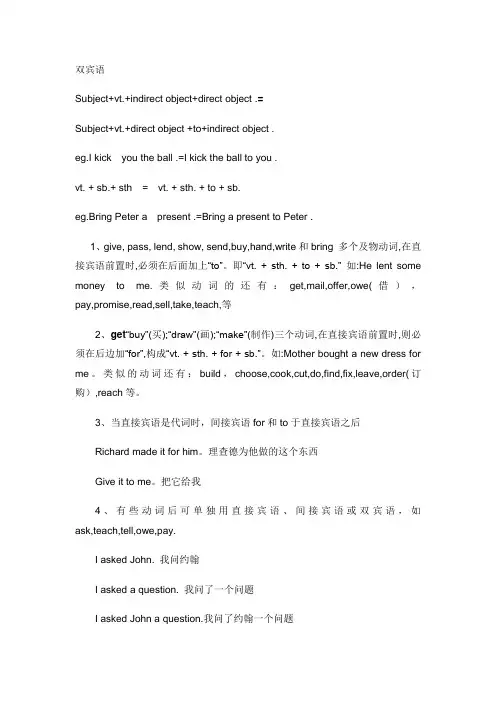
双宾语Subject+vt.+indirect object+direct object .=Subject+vt.+direct object +to+indirect object .eg.I kick you the ball .=I kick the ball to you .vt. + sb.+ sth = vt. + sth. + to + sb.eg.Bring Peter a present .=Bring a present to Peter .1、give, pass, lend, show, send,buy,hand,write和bring 多个及物动词,在直接宾语前置时,必须在后面加上“to”。
即“vt. + sth. + to + sb.” 如:He lent some money to me.类似动词的还有:get,mail,offer,owe(借),pay,promise,read,sell,take,teach,等2、get“buy”(买);“draw”(画);“make”(制作)三个动词,在直接宾语前置时,则必须在后边加“for”,构成“vt. + sth. + for + sb.”。
如:Mother bought a new dress for me。
类似的动词还有:build,choose,cook,cut,do,find,fix,leave,order(订购),reach等。
3、当直接宾语是代词时,间接宾语for和to于直接宾语之后Richard made it for him。
理查德为他做的这个东西Give it to me。
把它给我4、有些动词后可单独用直接宾语、间接宾语或双宾语,如ask,teach,tell,owe,pay.I asked John. 我问约翰I asked a question. 我问了一个问题I asked John a question.我问了约翰一个问题5、suggest,explain,introduce,mention,deliver,announce等动词后必须跟介词to,不能进行直接宾语与间接宾语的转换。
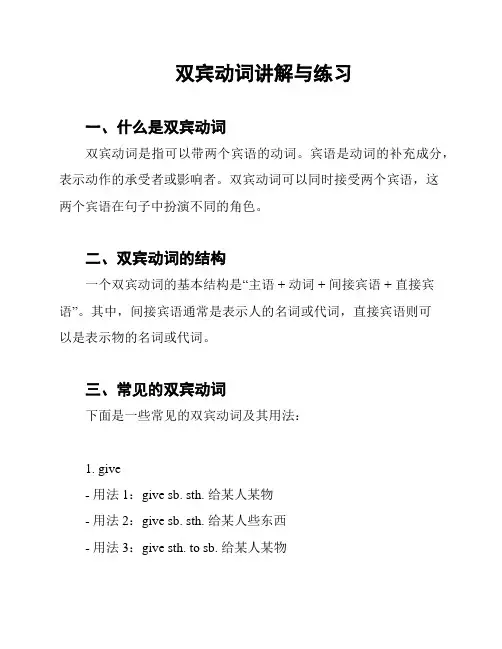
双宾动词讲解与练习一、什么是双宾动词双宾动词是指可以带两个宾语的动词。
宾语是动词的补充成分,表示动作的承受者或影响者。
双宾动词可以同时接受两个宾语,这两个宾语在句子中扮演不同的角色。
二、双宾动词的结构一个双宾动词的基本结构是“主语 + 动词 + 间接宾语 + 直接宾语”。
其中,间接宾语通常是表示人的名词或代词,直接宾语则可以是表示物的名词或代词。
三、常见的双宾动词下面是一些常见的双宾动词及其用法:1. give- 用法1:give sb. sth. 给某人某物- 用法2:give sb. sth. 给某人些东西- 用法3:give sth. to sb. 给某人某物2. show- 用法:show sb. sth. 展示给某人某物 / show sth. to sb. 给某人展示某物3. tell- 用法1:tell sb. sth. 告诉某人某事- 用法2:tell sb. to do sth. 告诉某人做某事4. send- 用法1:send sb. sth. 给某人寄送某物- 用法2:send sth. to sb. 将某物寄送给某人5. bring- 用法1:bring sb. sth. 给某人带来某物- 用法2:bring sth. to sb. 带某物给某人6. write- 用法:write sb. sth. 给某人写信四、练题根据句意,选择合适的双宾动词填空:1. Could you ___________ me your pen?- A) give- B) show- C) tell- D) send2. Can you ___________ the book ___________ me, please? - A) bring / to- B) give / to- C) send / to- D) show / to- A) gave- B) told- C) sent- D) brought4. Please ___________ the letter ___________ your mother.- A) send / to- B) give / to- C) tell / to- D) show / to5. He ___________ her some flowers on her birthday. - A) gave- B) wrote- C) sent- D) brought答案:1. A2. A3. B4. A5. C五、总结通过研究双宾动词的讲解和练,我们了解到双宾动词是指可以带两个宾语的动词。
页眉内容双宾动词主攻语法:后面带直接宾语和间接宾语(即双宾语)的动词用法语法秘籍:1直接宾语就是被动词直接作用的物(sth.),间接宾语通常是指人(sb.)。
间宾如果使用代词,必须是宾格形式。
2.它们跟在动词后面有两种顺序人前物后,人+物即:V + sb. sth物前人后,物to 人即: V + sth. to sb.3.这样的动词有:give(给)bri ng(带来)take(拿),le nd(借给)p ay(支付),pass 传递),read(读),tell(告诉),send送;发送),show(给看),teach(教),hand(递给)等。
如:Let me tell you a story. = Let me tell a story to you. 我给你讲个故事吧。
Please hand met he cup. = Please hand the cup to me.请把那个杯子递给我。
专项练习、模仿例句改写以下例句。
(关键一定要找准,找全sth和sb.) 1.Send George that letter.2.Take her those flowers.3.Show me that picture.4.Give Mrs. Jones these books.5.Give the children these ice creams.、改写以下句子,改变划线部分在句中的位置。
1.Give this key to Penny, please.2.Don't give that one to him.3.Send these flowers to her.4.Don't show your homework to Sam.5.Bring these magazines to Sally.6.Hand the hammer to your father.7.Don' t send these tickets to them.8.Can you lend an English book to me?9.Pass the ball to her, please.10.Tell the truth to me.三、汉译英。
专题三:动词不定式+双宾语一.动词不定式含义当我们要表示“想做某事、需要做某事或决定做某事”时,就会出现两个动词连用的情况,这时应如何表达呢?同学们自然会想到want to do sth.,need to do sth.和decide to do sth.等表达方式。
行为动词后的动词都采用了“to+动词原形”的结构。
我们把这种结构称为动词不定式。
动词不定式没有人称和数的变化,在句中不能作谓语。
二.动词不定式的功能1.动词不定式作宾语(1)动词+to do sth.表示的多为将来的行为。
如:want to do sth. / hope to do sth. / learn to do sth. / try to do sth. / decide to do sth. / forget to do sth. / remember to do sth. / stop to do sth./ plan to do sth.等(2)to有时可省略,结构为动词+do sth.had better do sth. / why not do sth.2.动词不定式作宾语补足语(1)宾语补足语是对宾语的补充说明,结构:“动词+宾语+动词不定式”。
其否定结构要在to do 前面加not,构成not to do。
如:allow sb. to do sth. / choose sb. to do sth. / want sb. to do sth. / tell sb. to do sth. / ask sb. to do sth. / invite sb. to do sth. /(2)在表示感觉、祈使等意义的动词help, make, let, have, feel, see等后接不带to 的不定式。
3.动词不定式作目的状语(1)如果表示“做某事是为了什么”,可以用动词不定式表示目的,常与soas,in order等构成短语不定式既可以放在句首,也可以放在句尾。
语法专项练习--------- 五种基本句型及句子成分的分析五种基本句型之主语+谓语+宾语(sb.)+宾语(something)这个句型比上面的句型多了个宾语,谓语后面已经是两个宾语了,那么谓语动词是及物动词是必定无疑了。
这两个宾语放在一起叫双宾语(间接宾语+直接宾语),e.g.:Lend me your dictionary, please.此句型的关键是记住哪些动词后面要接双宾语,因为并不是所有的及物动词后面都可以接宾语的,只有少数的动词。
此句型中的谓语动词后接两个宾语:前一个宾语称为"间接宾语",多由代词或名词充当;后一个宾语称为"直接宾语",往往由名词充当。
这类句型常有"给某人某物"、"送某人某物"、"留给某人某物"等意思。
(所有能带双宾语的动词含义的内核含有一个“给”字。
常见的这类谓语动词有:give(给某人……), give sb. sth. bring (带给某人……), bring sb. sth. tell(告诉某人……), tell sb. sth. send(送给某人……), send sb. sth. leave(留给某人……), leave sb. sth. pass(递给某人……), pass sb. sth. read(给某人读……), read sb. sth. write(给某人写……), write sb. sth. take(给某人拿……), take sb. sth. show(给某人看……), show sb. sth. teach(教给某人……), teach sb. sth. get(给某人弄到……), get sb. sth. lend(借给某人……), lend sb. sth. buy(给某人买……), buy sb. sth. pay(支付给某人……), pay sb. sth. hand(递给某人……) hand sb. sth.(注:上面各词的中文释义是刻意按照该词的常用动词句型而给的,以便于大家更好地理解该词出现于哪个基本句型中。
宾语从句讲解及专项练习注意!宾语从句小口诀:宾语从句三注意,时态语序引导词;主句一般现在时,从句不需受限制;主句一般过去时,从句须用相应时;陈述句转化that引,一般疑问句用if/whether,特殊问句疑问词,引导词后陈述式。
一、基本讲解1 概念:在句中担当宾语的从句叫宾语从句,宾语从句可作谓语动词的宾语,也可做介词的宾语。
eg, He said he was good at drawing. (动词宾语)He asks him how long Mike has been down . (动词宾语)Miss Zhang is angry at what you said. (介词宾语)2.连接词(1) .陈述句转化成宾语从句时,引导词用that,口语中常常省略。
e.g, She told me (that) she would like to go with us.(2)以 whether 或 if 引导的宾语从句, 主要用来引导一般疑问句意思或选择疑问句意思的宾语从句,从句同样是陈述语序eg, I wonder if /whether you have told the news to Li Lei .注意:一般情况下,whether 和if 可以互用,但有些情况例外。
a. 当从句做介词的宾于是只用whether 不用ifeg, We are talking about whether we'll go on the pinic.b. 引导词与动词不定式或 not 连用时,只用whether.eg, Please let me know what to do next.Could you tell me whether u go or not?c. if当如果讲时,引导的是条件状语从句,这时不能用whether.(3).特殊疑问句转化成宾语从句时,引导词用特殊疑问词;引导词后要用陈述句语序。
双宾语练习题双宾语练习题语法是学习一门语言的基础,而双宾语结构是英语语法中的一个重要部分。
双宾语结构指的是一个动词可以同时接受两个宾语,一个直接宾语和一个间接宾语。
在本文中,我们将通过一些练习题来帮助大家更好地理解和运用双宾语结构。
练习一:选择正确的双宾语1. My mother bought _______ a new book for my birthday.A. meB. IC. myD. mine2. The teacher gave _______ a gold star for her excellent work.A. sheB. herC. hersD. herself3. Can you lend _______ your pen for a moment?A. IB. meC. myD. mine4. The company offered _______ a promotion and a pay raise.A. IB. meC. myD. mine5. They showed _______ the way to the nearest bus station.A. IB. meC. myD. mine答案解析:1. A. me在这个句子中,"my mother"是动词"bought"的直接宾语,而"me"是动词的间接宾语。
2. B. her"the teacher"是动词"gave"的直接宾语,而"her"是动词的间接宾语。
3. B. me"you"是动词"lend"的直接宾语,而"me"是动词的间接宾语。
4. B. me"the company"是动词"offered"的直接宾语,而"me"是动词的间接宾语。
总结双宾语初中在学习英语中,双宾语是一个重要的语法结构。
初中阶段是学习双宾语的关键时期,因此总结双宾语的用法和特点对于学生来说非常重要。
本文将总结双宾语的基本概念、用法和常见错误,并给出一些练习题供学生复习和巩固知识。
1. 双宾语的定义和形式双宾语指的是一个动词可以同时接受两个宾语的情况。
一般来说,双宾语的形式是 verb + ind. obj. + dir. obj.,也就是动词 + 间接宾语 + 直接宾语。
其中,动词是表示给予、告诉、发送、买、卖等操作的动作词,间接宾语指的是接受或受益的人或事物,直接宾语指的是受作用的人或事物。
下面是一些常见的双宾语动词和它们的例句:•give(给予):I gave my sister a book.(我给了我妹妹一本书。
)•tell(告诉):She told me a story.(她给我讲了一个故事。
)•send(发送):He sent his friend a postcard.(他给他的朋友寄了一张明信片。
)•buy(买):We bought her a gift.(我们给她买了个礼物。
)2. 双宾语的特点和用法双宾语的特点有以下几点:•双宾语通常由直接宾语和间接宾语组成,直接宾语在前,间接宾语在后。
•直接宾语通常是物品,间接宾语通常是人或动物。
•双宾语结构中的宾语可以互换位置,但仍然保持同样的意思。
双宾语在句子中的应用也有一些规律:•动词 + ind. obj. + dir. obj. 的句子结构非常常见,可以使用这种结构来表达给予、告诉、发送等动作。
•当句子中有多个宾语时,通常使用介词 to 或 for 来区分直接宾语和间接宾语。
•当句子中的宾语较长或复杂时,可以使用双宾语结构来使句子更加简洁明了。
3. 常见错误及解决方法在学习双宾语时,有些学生容易犯一些常见的错误。
以下是一些常见错误及解决方法的总结:•错误:They gave me a present for my birthday. 解决方法:将直接宾语和间接宾语的位置互换,They gave a present to me. 或 They gave me apresent.•错误:He told us a joke what happened to his friend. 解决方法:将what happened to his friend 改为 that happened to his friend 或者 whathappened to his friend. 例如:He told us a joke that happened to his friend.•错误:She sent a letter to me for help. 解决方法:将 to me for help 改为 for my help. 例如:She sent a letter to me for my help.•错误:We bought a new car our parents. 解决方法:将直接宾语和间接宾语的位置互换,We bought our parents a new car. 或 We bought a new car for our parents.4. 练习题为了帮助学生巩固双宾语的用法,下面提供一些练习题:1.He gave his sister a __________ for her birthday.(book / her / gave)2.We told him the ___________ about the party.(truth / him / told)3.She sent me a ___________ to thank me.(letter / her / sent)4.They bought their son a __________ for his graduation.(car / their son /bought)结论通过对双宾语的概念、用法和常见错误的总结,学生们可以更好地掌握双宾语的正确使用。
双宾动词主攻语法:后面带直接宾语和间接宾语(即双宾语)的动词用法语法秘籍:1.直接宾语就是被动词直接作用的物(sth.),间接宾语通常是指人(sb.)。
间宾如果使用代词,必须是宾格形式。
2. 它们跟在动词后面有两种顺序人前物后,人+物即:V + sb. sth.物前人后,物to 人即: V + sth. to sb.3.这样的动词有:give(给)bring(带来)take(拿), lend(借给) pay(支付), pass(传递), read(读), tell(告诉), send(送;发送), show(给看), teach(教),hand(递给)等。
如:Let me tell you a story. = Let me tell a story to you. 我给你讲个故事吧。
Please hand met he cup. = Please hand the cup to me.请把那个杯子递给我。
专项练习一、模仿例句改写以下例句。
(关键一定要找准,找全sth.和sb.)1.Send George that letter.___________________________________________________2.Take her those flowers.____________________________________________________3.Show me that picture._____________________________________________________4.Give Mrs. Jones these books._____________________________________________________5.Give the children these ice creams._____________________________________________________二、改写以下句子,改变划线部分在句中的位置。
1. Give this key to Penny, please._____________________________________________________________2.Don’t give that one to him._______________________________________________________________3.Send these flowers to her.___________________________________________________________________ 4.Don’t show your homework to Sam.____________________________________________________________________ 5.Bring these magazines to Sally.____________________________________________________________________ 6.Hand the hammer to your father._____________________________________________________________________ 7.Don’t send these tickets to them._____________________________________________________________________ 8.Can you lend an English book to me?_____________________________________________________________________ 9.Pass the ball to her, please._____________________________________________________________________ 10.Tell the truth to me.___________________________________________________________________三、汉译英。
1. 我打算送给她一些花儿。
send sb. sth.send sth. to sb.2. 不要把信给你的朋友看。
show sb. sth.show sth. to sb.3. 请递给我一杯水。
pass sb. sth.pass sth. to sb.4. 我要把信发给我的奶奶。
send sb. sth.send sth. to sb.5. 请把这些礼物给孩子们。
give sb. sth.give sth. to sb.6. 我把他送到了学校。
take sb. sth.7. 我借给他一本故事书。
lend sb. sth.lend sth. to sb.8. 我给她看了我的新裙子。
show sb. sth.show sth. to sb.9. 你打算把那些照片送给谁?send sth. to sb.可接双宾语的38个常用动词(1) 双宾语易位时需借助介词to的常用动词award sb. sth. = award sth. to sb. 颁奖给某人bring sb. sth. = bring sth. to sb. 把某物带给某人hand sb. sth. =hand sth. to sb. 把某物递给某人lend sb. sth. = lend sth. to sb. 把某物借给某人offer sb. sth. = offer sth. to sb. 将某物给某人owe sb. sth. = owe sth. to sb. 欠某人某物pass sb. sth. = pass sth. to sb. 把某物递给某人pay sb. sth. = pay sth. to sb. 付给某人某物(钱)post sb. sth. = post sth. to sb. 把某物寄给某人read sb. sth. = read sth. to sb. 把某物读给某人听return sb. sth. = return sth. to sb. 把某物还给某人send sb. sth. = send sth. to sb. 把某物送给某人sell sb. sth. = sell sth. to sb. 把某物卖给某人serve sb. sth. = serve sth. to sb. 拿某物招待某人show sb. sth. = show sth. to sb. 拿某物给某人看take sb. sth. = take sth. to sb. 把某物拿给某人teach sb. sth. = teach sth. to sb. 教某人某物tell sb. sth. = tell sth. to sb. 告诉某人某情况write sb. sth. = write sth. to sb. 给某人写信(2) 双宾语易位时需借助介词for的常用动词book sb. sth. = book sth. for sb. 为某人预定某物buy sb. sth. = buy sth. for sb. 为某人买某物choose sb. sth. = choose sth. for sb. 为某人选某物cook sb. sth. = cook sth. for sb. 为某人煮某物draw sb. sth. = draw sth. for sb. 为某人画某物fetch sb. sth. = fetch sth. for sb. 为某人去取某物find sb. sth. = find sth. for sb. 为某人找到某物fix sb. sth. = fix sth. for sb. 为某人准备某物get sb. sth. = get sth. for sb. 为某人拿来某物make sb. sth. = make sth. for sb. 为某人做某物order sb. sth. = order sth. for sb. 为某人订购某物pick sb. sth. = pick sth. for sb. 为某人采摘某物prepare sb. sth. = prepare sth. for sb. 为某人准备某物save sb. sth. = save sth. for sb. 为某人留某物sing sb. sth. = sing sth. for sb. 为某人唱某物(歌)spare sb. sth. = spare sth. for sb. 为某人让出某物steal sb. sth. = steal sth. for sb. 为某人偷某物注:有的动词后接的双宾语易位时,既可用介词to引出间接宾语,也可用介词for引出间接宾语,含义相同,如bring,play等:B ring me today’s paper. = Bring today’s paper to [for] me. 把今天的报纸拿给我。
He played us the record he had just bought. = He played the record he had just bought for [to] us. 他放了他刚买的唱片给我们听。
有的动词后接的双宾语易位时,即可用介词to引出间接宾语,也可用介词for 引出间接宾语,含义不同,如leave等:They left me no food. = They left no food for me. 他们没给我留一点食物。
My uncle left me a large fortune. = My uncle left a large fortune to me.我叔叔死后留下一大笔财产给我。
而有的动词后接双宾语时,既不能用介词to引出间接宾语,也不能用介词for 引出间接宾语,如allow, ask, cause, charge, cost, forgive, refuse等:He allows his son too much money. 他给他儿子的钱太多。
He asked me some questions. 他问了我一些问题。
This caused me much trouble. 着给我带来了许多麻烦。